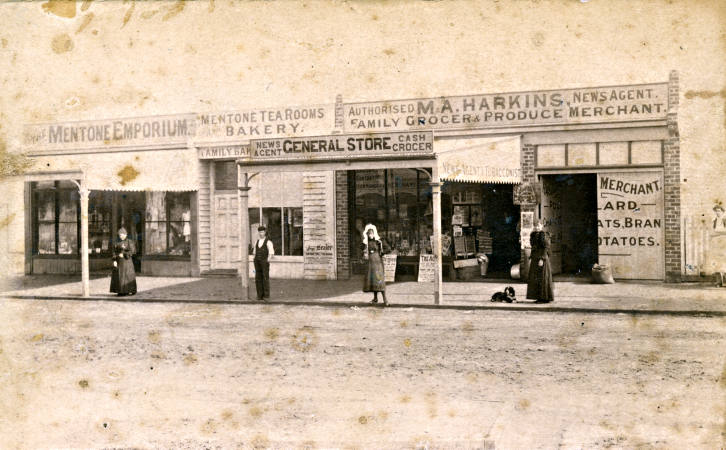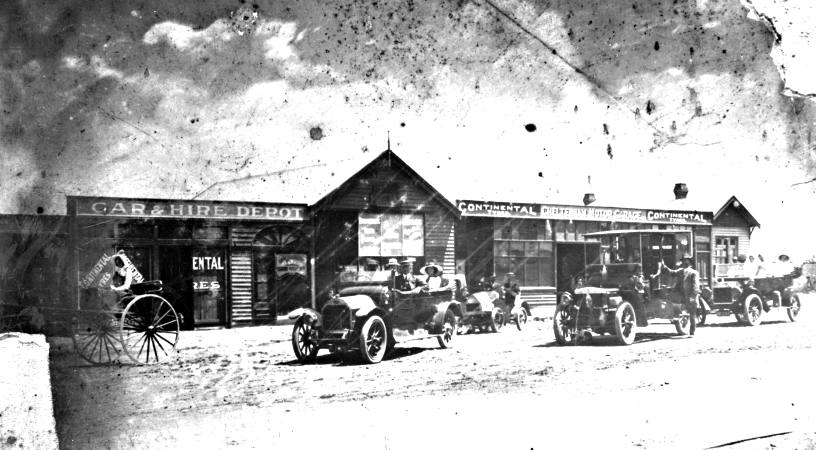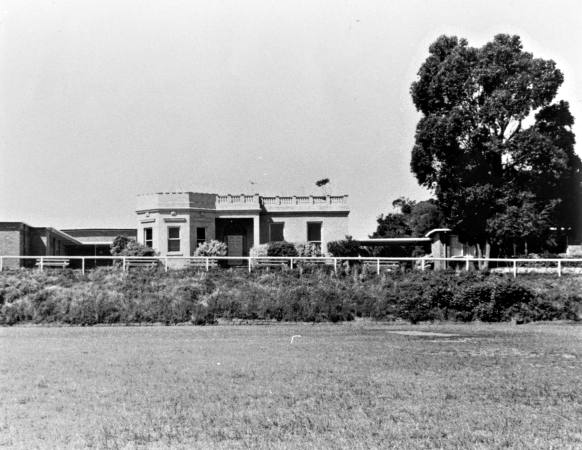Mentone’s Harkins and Tovey Families

James Tovey and John Harkins of Warrigal Road, Mentone, with relatives, 1910. Courtesy Mordialloc and District Historical Society.
A century ago the exploits of individual families often loomed larger in the life of small towns such as Mentone than they do today. In the early 1900s Mentone people knew most of the few hundred other townsfolk and were quick to learn about each other’s successes and unusual achievements. In this setting the Harkins and Tovey families, related to one another by marriage, were very well known in the town.
John Harkins was the first to make an impact. He came to Australia from Scotland on the Salier in 1887, aged 26, and later established a printing business in South Melbourne. Harkins had success in this business during the prosperous land boom period and apparently was shrewd in his business dealings. He needed to be because when he immigrated to Australia he came with his widowed mother, two brothers and five sisters. John’s father, a railway guard, had been killed in an accident in Perthshire and the Scottish railway authorities did a deal with the family in which they would relinquish any claim for compensation in return for assisted passage to Australia. As the eldest of the three boys John would have borne some responsibility to provide for the family in Australia, although it is not clear how materially well-off his mother was, or how many of his sisters were able to work when they first arrived in Melbourne. In 1896 another brother and sister came out from Scotland, undoubtedly adding to John’s responsibilities.
When the crash of the early 1890s ruined many of Melbourne’s land speculators and others connected with them, John Harkins must have escaped serious financial difficulty because in the early 1890s he purchased substantial property in Mentone. Palermo and Ivanhoe, two adjacent houses near the corner of Moorabbin Road and Como Parade West, were bought by Harkins in 1894 when properties were going cheap because their owners could not pay their debts. Ivanhoe, long since demolished, was used by the large family, principally John’s sisters who lived there till they married or moved away for other reasons. Palermo was the grander home with its turret-like upper section. In those days it had a rather ungainly superstructure which allowed a view of the bay. These two homes had large areas of land around them so that Harkins owned a tract that stretched from the railway down to Naples Road.

’Palermo’, home of Harkins family, Warrigal Road, Mentone.
John Harkins continued to run his printing business, commuting by train to South Melbourne. He is listed in Sands and McDougall’s Victorian Directories as a printer until the World War 1 period. But Harkins had a Mentone business as well. In the late 1890s, as Mentone struggled to recover from the economic depression, he bought three adjacent shops on the corner of Mentone Parade and Florence Street (north side). The corner shop was named ‘Mentone Emporium’ and sold clothing, household items and giftware. Next door was ‘Mentone Teahouse and Bakery’, while a general store selling groceries, as well as hay, corn, bran and potatoes, completed the Harkins retail establishment. At the time these shops represented a large percentage of the town’s businesses so John Harkins played a role in keeping Mentone alive after the economic ravages that occurred when the land boom collapsed. He employed his sisters and at least one of his younger brothers, Jim, to run these shops. It is hard to tell how successful the retailing was, because in 1904 the shops were bought by Abbott and Mason who expanded the businesses, especially after Abbott separated from his partner and, in 1923, built the brick edifice that remains to this day on that corner.

Corner Mentone Parade and Florence Street – M A Harkins, Newsagent, General Store and Produce Merchant, Mentone Tea Rooms and Bakery, Mentone Emporium, c1895. Courtesy Jean Steward.
Presumably Harkins continued his printing business and the rest of the family moved to other occupations when the shops were sold. Five of his six sisters were married from Ivanhoe in the period around 1900 so the shops would have run out of managers, it being the custom then for most women to retire from work when they married. John Harkins had plenty of other property and also owned a motor garage and car hire service located on Point Nepean Road, Cheltenham. As time went on he acquired property in St Kilda, South Yarra, Hastings and Beaconsfield, demonstrating a skill in wealth management. He died in 1935 aged 74.

John Harkins’ Garage, Point Nepean Road, Cheltenham - opposite Memorial Soldiers' Hall, C1913. Courtesy Mordialloc and District Historical Society.
The third eldest sister of John Harkins, Ann, married an academic man called James Tovey in 1898. The newlyweds settled next door to Ivanhoe in rather unusual accommodation. Harkins procured a timber cottage in Collingwood and had it transported to Mentone where it was re-erected facing the railway and Como Parade West, but still in the grounds of Harkins’ other two houses. James and Ann Tovey moved into this modest home and remained there for over two decades. James Tovey was a botanist who began his career at sixteen under the supervision of Baron Ferdinand Von Mueller, noted Government Botanist, at the Botanic Gardens in Melbourne. For the next 33 years James established his career and rose to be head of the National Herbarium, located in the gardens. Notably, he discovered a rare orchid in the Mentone and Cheltenham heathlands in 1907, well before the native vegetation was destroyed by building activity. It was eventually named after him (Pterostylis Toveyana). In 1921 he identified Australian native plants that would be suitable for planting around war graves at Gallipoli and other places where Australian soldiers were buried. James Tovey was stricken with a debilitating disease that caused paralysis during his last few years, but he managed to keep working at the Herbarium until near the end of his life, helped by one of his daughters who wheeled him to his duties in a wheelchair. James Tovey died at 49 and was buried at Cheltenham on New Year’s Day, 1923. Ann, his wife, lived until 1950, the couple having produced two daughters, and a son, Dick, who ran a removalist business for many years in the local area. Lee Renouf, one of the Tovey daughters, lived in Mentone until the late 1980s.

James R Tovey - resident of Mentone - assistant botanist at the National Herbarium, Botanical Gardens, c1910.
The Tovey home, Viola, became the subject of a dispute in 1984. In the mid-nineteenth century it had been imported from Asia, possibly Singapore, in pre-fabricated condition, and erected in Collingwood to alleviate the housing shortage that occurred in Melbourne after the Gold Rushes. Its timbers had Chinese characters marking various parts and its roof was of a distinctive ribbed iron design. Mentone Grammar School eventually purchased the house but its site was required for an indoor swimming pool and related facilities to be built during the 1980s. The school planned to demolish it in 1984. Mordialloc Historical Society, through the energy of Laura Ferguson, a very active member, mounted a campaign to save the house as a surviving example of the imported pre-fab. homes from the previous century. Eventually it was saved from demolition and removed to Collingwood.

’Viola’, the family home of the Tovey family, c1960. Courtesy Mordialloc and District Historical Society.
The other house of the Harkins-Tovey family, Palermo, passed into the ownership of St Patrick’s Catholic parish for a short time around 1950. Father Frank O’Hanlon had a grand scheme for a Catholic Technical School on the site but that idea lapsed as funds were allocated to other works on the primary school and the new church that was erected in the late fifties. Mentone Grammar School bought Palermo and it served as part of the Junior School for many years, even after Viola disappeared, but it too was to make way for new buildings, notably the new Don Ingram complex, opened as we moved into a new millennium.

’Palermo’ later called ‘Bayview’, c1940. Courtesy Mordialloc and District Historical Society.
There are now no physical reminders of a family that made a significant contribution to early Mentone life. However, one of the Harkins men left some memories that have grown in importance with the years. James Harkins, the second youngest of the brothers, many years junior to John, enlisted in the army early in World War 1 aged in his late thirties. He was posted to France in 1916 and saw service there until 1918. Private Harkins began sending letters from the frontline to be printed in the Moorabbin News where his descriptions of the war informed the locals about the horrors men were enduring. He made impassioned appeals for Australian men to enlist and come over to help their mates. These letters have now become more interesting as historical sources that we can use to evaluate the events and the mood of the period. James Harkins wrote very fluent and luridly descriptive pieces from which can be gauged the suffering that occurred in France on a massive scale. On April 7 1917 Moorabbin News published a letter where Harkins expressed his indignation over reports that some people in Australia thought the AIF was on a holiday trip in France. Here is part of the Harkins response:
Have they ever plugged thigh-deep in slush and mud; ever heard the call of a comrade buried to his neck by bursting shells; felt the concussion of the explosion of a concentrated earthquake.
Nor do they endeavour to slumber with feet like lead and limbs cramped in crouched posture with oozing slime for a couch.
The writers of this optimistic fiction have not seen comrades fall around; have not heard the moan of the wounded; nor have they assisted a worn and broken comrade to a stretcher.
They have not seen their fellow beings - friend and foe alike - staring with sightless eyes in crouching attitude in vain endeavour to shield from the death blow.
Nor have they seen prostrate forms, lifeless and bloodless; nor have they dragged themselves through mire and mud to billets where a respectable householder would not house his dog.
Earlier, in 1916, he had described the constant shelling from the enemy:
The earth trembles and heaves with concussion and tearing. Trenches disappear with lightning rapidity, their occupants perhaps buried in avalanches or succoured in some dugout and safe…………….The blackness overhead becomes a furnace. Flares and flashes of red hot bursting shrapnel add to the inferno. A double dose of Hell is served out and Dante is outdone.
Later he also wrote:
Sleep there is none, day or night, until nature can afford to stand out no longer, and a few winks are snatched squatting in mud amidst the continual boom of the guns.
James Harkins was probably a well-educated man, judging from his descriptions of the war. He left us evidence of his wartime hell. Sadly, the war affected him so badly that he returned a ruined man, living out his final years in a bungalow at the back of the old Harkins residence. What a pity he did not write more. His descriptions of life in Mentone a century ago when he was a young man would have been wonderful. He could have given a more complete picture of the ways the Harkins and the Tovey families helped in Mentone’s development.

Harkins Family at their Mentone residence ‘Palermo’, Warrigal Road. Property later bought by Mentone Boys' Grammar School, C1899. Courtesy Mordialloc and District Historical Society.
Footnotes
- Moorabbin News: Various editions after 1900, including those from the war period (1916-18).
- Various clippings from a file on the Harkins and Tovey families kept at the Laura and Charles Ferguson Museum, Old Bakery Lane, Mentone.
- Mordialloc-Chelsea News, Feb. 29th, 1984. Details of the removal of the house, Viola, from Mentone Grammar’s campus.
- Information supplied by Judy Bowman and Wendy Evans, grand daughters of James and Ann Tovey.
